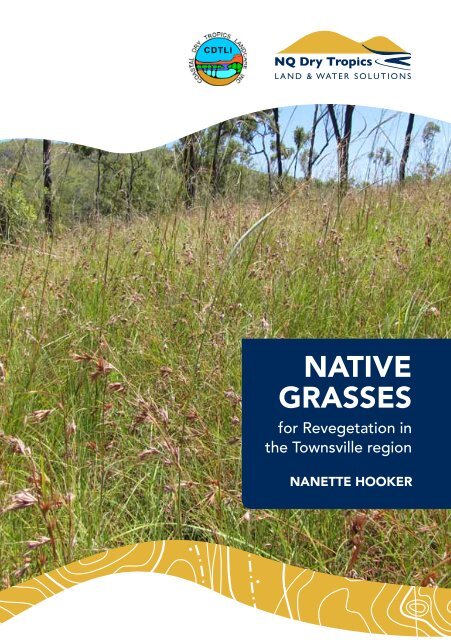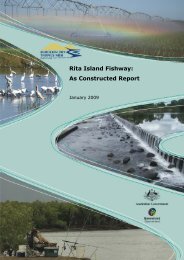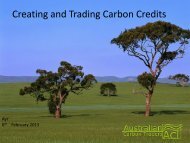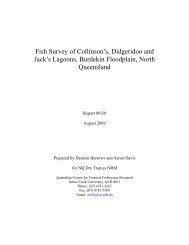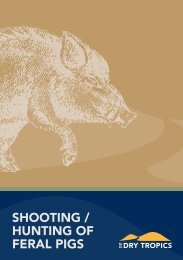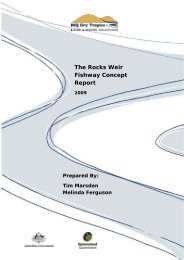NATIVE GRASSES - Wiki - NQ Dry Tropics
NATIVE GRASSES - Wiki - NQ Dry Tropics
NATIVE GRASSES - Wiki - NQ Dry Tropics
You also want an ePaper? Increase the reach of your titles
YUMPU automatically turns print PDFs into web optimized ePapers that Google loves.
<strong>NATIVE</strong><strong>GRASSES</strong>for Revegetation inthe Townsville regionNANETTE HOOKER
www.jcu.edu.auNative Grasses for Revegetation in the Townsville RegionCopyright 2011 Nanette HookerPublished by <strong>NQ</strong> <strong>Dry</strong> <strong>Tropics</strong>ISBN 978-0-9757730-1-7Text: Nanette Hooker, James Cook University, TownsvillePhotographs: Chris Gardiner, James Cook University, TownsvilleEditors: Ramona Rohwedder, Kim Sellars of Coastal <strong>Dry</strong> <strong>Tropics</strong> Landcare Inc., TownsvilleDistribution maps from AusGrass CD (Sharp and Simon 2002)Please reference as: Hooker, N 2010, Native Grasses for Revegetation in the Townsville Region, Coastal<strong>Dry</strong> <strong>Tropics</strong> Landcare Inc., Townsville.Further copies may be obtained fromCoastal <strong>Dry</strong> <strong>Tropics</strong> Landcare Inc.PO Box 1390Townsville Qld 4810or from our websitewww.cdtli.org.auThis publication was made possible throughthe support of an Australian Government Grant.The Copyright Act 1968 permits fair dealing for study, research, news reporting,criticism or review. Selected passages, tables or diagrams may be reproduced for suchpurposes provided acknowledgement of the source is included. Major extracts of theentire document may not be reproduced by any process without written permission ofthe author or the President of Coastal <strong>Dry</strong> <strong>Tropics</strong> Landcare Incorporated.Disclaimer: The information contained in this publication has been compiled in goodfaith from sources Coastal <strong>Dry</strong> <strong>Tropics</strong> Landcare Inc. (CDTLI) believes to be reliable.However, CDTLI, its board, members, employees and consultants do not invite relianceupon, nor accept responsibility for, the accuracy or completeness of the information.Before relying on any information in this publication, the reader should make theirown enquiries and seek independent professional, scientific and technical advice. Thereliance upon and /or use of any information contained in this publication shall be atthe reader’s own risk and no liability will be accepted for any consequences which mayarise directly or indirectly as a result.
CONTENTSWelcome 4Introduction 5The grass plant 6The grass inflorescence 7Places to obtain local native grasses 7Alloteropsis semialata (Cockatoo Grass) 8Arundinella nepalensis (Reed Grass) 9Chrysopogon fallax (Golden Beard Grass) 10Cymbopogon bombycinus(Silky Oilgrass, Silky Heads, Citronella Grass) 11Enneapogon robustissimus (Nineawn Grass) 12Eragrostis elongata (Clustered Lovegrass) 13Heteropogon triticeus (Giant Speargrass) 14Ischaemum australe (Large Bluegrass) 15Sarga plumosum (Plume Sorghum) 16Setaria surgens (Pigeon Grass) 17Themeda triandra (Kangaroo Grass) 18Thuarea involuta (Tropical Beachgrass, Bird’s Beak Grass) 19Index of common names 20References 20Table of growth features 21Field Measuring GridBack Cover3
WELCOMEWelcomeThank you for your interest in this booklet.As the regions natural resource management company, <strong>NQ</strong> <strong>Dry</strong> <strong>Tropics</strong> is proud to providefinancial support for the publication of this book. We believe that in the aim of increasingknowledge and understanding of management of our land and water resources it is importantto share information with the people who will ultimately make the difference – you.We congratulate the author, Nanette Hooker for her time and effort in compiling the bookand appreciate you for taking an interest in the process of native grass revegetation.<strong>NQ</strong> <strong>Dry</strong> <strong>Tropics</strong> is a not-for-profit company that has been a leading delivery agent of landand water management change across the Burdekin <strong>Dry</strong> <strong>Tropics</strong> region since 2005. We workacross an area of 134,000 square kilometres.Our primary focus is to work with stakeholders across the region that have an interest in theuse and management of our natural resources by providing direction, information, advice andpractical support. As a land owner ourself and a land manager we implement and promotebest practice land management principles and demonstrate leadership in land and waterresource management.We’re dedicated to providing knowledge and expertise, robust ‘evidence based’management and collaboration facilitation to achieve agricultural sustainability, increasedwaterway health, biodiversity protection and coastline sustainability.4
IntroductionThe grass family (Poaceae) is one of the largest and most cosmopolitan of the flowering plantfamilies of the world comprising more than 10,000 species. Grasses are found almost everywhere(even Antarctica). They are adapted to a wide range of climatic and soil conditions, and grow inhabitats ranging from deserts to freshwater and marine environments. Grasses form a majorcomponent of many vegetation communities e.g. grasslands, steppe, prairie and savannas.Grasses are the most important plant family for humans. They provide a source of food (wheat,oats, maize, rice, sugarcane) and most of the grazing for wild and domesticated animals. Grass-usepervades all aspects of human endeavour: building materials, artistic pursuits, sports and leisureactivities. New uses of grasses are still being found e.g. for environmental management. Humanshave used grasses in a multiplicity of ways over a great period of time.Native grasses are an important and integral component of many vegetation communities; thereforethey have an important role to play in rehabilitation and revegetation programs. Grasses havefibrous root systems and they can hold soil together and reduce erosion. Certain grass species canbe used to prevent soil erosion on unstable surfaces such as beach sands (Thuarea involuta) andriparian areas (Arundinella nepalensis).Australian grasses provide food and shelter for many Australian birds and animals. The seeds ofmany native grasses are important components in the diet of several granivorous parrots and finches(Alloteropsis semialata, Chrysopogon fallax, Eragrostis species, Heteropogon triticeus, Sargaplumosum, Setaria surgens), and the bulbous bases of some grasses are a food source for a numberof native animals (Alloteropsis semialata, Chrysopogon fallax). The leaves of many species ofgrasses are used for nest and burrow linings for many Australian birds, animals and reptiles; alsosome grass species (Sarga plumosum, Themeda triandra) are the main component in the diet ofmany Australian herbivores.In Australia there are over 1300 species of grass including non-native grasses. In the Townsvilleregion there are more than 220 grass species, 160 of these are native. Twelve species have beenselected for inclusion in this booklet. The choice of these species was based on a number of factors:annuals to long-lived perennialsvariable heightsvariable environmental requirementsavailability of seedsgermination knowledgeavailability of seedlingsA table at the back of the booklet summarises some of these features.Planning is one of the most important aspects of any revegetation effort and the decision whetheror not to use Australian native grasses is an integral part of this process. Most grasses grow best infull sun or partial shade and revegetation sites need to be prepared to give the new grasses the bestpossible chance of survival.Although Australian native grass species are considered as being low input and low maintenance,this should not be confused with “zero” management. In many revegetation sites there may be anumber of introduced or weed grasses which superficially look similar to native species, particularlyseedlings. This is especially relevant in riparian areas where higher nutrient and moisture levelsmean there are probably dense stands of non-native grasses. For this reason, getting to know thegrass species on the site is very important.Most Australian native grasses do not have the ability to compete with robust, non-native grassese.g. Guinea Grass (Megathyrsus maximus), therefore it is best for the site to be free of these weedyspecies, or the site must be regularly maintained.25
Selection of appropriate native grasses for a particular site will depend on the proposed use of thearea e.g. erosion control. Some grass species can grow in a wide range of habitats and on a widerange of soil types.Suggested native grass species for some habitats are listed below.Riparian grassesArundinella nepalensisEnneapogon robustissimusEragrostis elongataSarga plumosumSetaria surgensOpen woodland grassesAlloteropsis semialataChrysopogon fallaxCymbopogon bombycinusEragrostis elongataHeteropogon triticeusSarga plumosumThemeda triandraWetland grassesEragrostis elongataIschaemum australeSarga plumosumBeach grassesEragrostis elongataSetaria surgensThuarea involutaThe grass plantThe use of technical terms is necessary when describing grasses. The diagram below illustrates someterms which may be used in this booklet.Terminology:Inflorescence – a group orcluster of flowersarranged on a stem.Spikelet – for flower orseed.Culm – stem.Leaf blade – the expandedupper part of a leaf.Ligule – a membranous orhairy appendage at thejunction of sheath andblade.Leaf sheath – the basalpart of a grass leafbetween the node and theligule; at maturity it oftencomes away from thestem.Node – the part of thestem from which the leafarises, usually thickened.Tiller – new shoot.Stolon – a trailing stemthat produces roots at thenodes.Drawing from Tothill and Hacker (1983)Rhizome – an undergroundstem, usually growinghorizontally, producingroots at the nodes.6 3
The grass inflorescenceThe basic grass inflorescence is composed of clusters ofspikelets (flowers) arranged in a panicle which may bemodified in a number of ways. The types of branching andthe arrangement of spikelets on the branches determinethe different types of grass inflorescence.Types of grass inflorescences:Raceme and SpikeThe inflorescence is unbranched: the raceme has spikelets withpedicels, the spike has spikelets without pedicels (i.e. spikelets aresessile)Open panicleInflorescence withbranches obviousSpicate panicleInflorescence withbranches not obviousSpatheate inflorescenceThe branches of theinflorescence aresubtended by spathes(leaf-like bracts)Digitate inflorescenceInflorescence branches arranged atthe top of peduncle like the fingersof the handPlaces to obtain local native grasses in TownsvilleGreening Australia <strong>Dry</strong> <strong>Tropics</strong> Nursery,1 Desailly Street, Gulliver@ Barrier Reef Institute of TAFE,Horticulture Unit, Pimlico CampusPh: (07) 4796 0411 Fax: (07) 4725 7922Email:drytropics@qld.greeningaustralia.org.auBush Garden Nursery,End of Thompson Street, MundingburraBehind the Townsville Community LearningCentre groundsPhone CVA: (07) 4721 4077Phone CDTLI: (07) 4721 432247
Alloteropsis semialataCockatoo GrassNAMEAlloteropsis is from the Greek allotrios (belonging to another) andopsis (appearance), the spikelets and inflorescences somewhatresemble another genus of grass; semialata, from the Latin semi(half) and ala (wing) and ata (possessing), referring to the wingedmargins of the upper glume.DESCRIPTIONAlloteropsis semialata is a tufted, perennial grass 20–100 cm tall.The base of the plant forms a bulb which is covered with dense,woolly hairs. The inflorescence consists of two to five finger-likebranches, 2–22 cm long.Cockatoo Grass is one of the first grasses to grow and ripen after theonset of the wet season, with flowering and seeding generallyoccurring about six weeks after the first rains.DISTRIBUTION AND HABITATThis grass is native to Australia, Asia and Africa. It is commonthroughout the tropics and subtropics of Australia and grows onsandy and loamy soils, including in eucalypt woodland.ECOLOGICAL NOTESThe seeds of this species are an important component in the wetseasondiet of several granivorous parrots and finches, includingmasked finch, black-throated finch, long-tailed finch, hoodedparrot, the endangered golden-shouldered parrot and theendangered gouldian finch. The bulbous bases of this grass are afood source for a number of animals e.g. Cockatoo Grass is animportant component of the northern bettong’s diet in the dryseason.Spikelet drawing from Sharp andSimon (2002)PROPAGATIONResearch has shown that the seeds of this species lose their viabilityafter one year unless stored in a freezer. Therefore seeds should be sown soon after collection orwithin 12 months of collection.8 5
Chrysopogon fallaxGolden Beard GrassNAMEChrysopogon is from the Greek chrysos (golden) and pogon(beard), alluding to the golden hairs on the inflorescence; fallaxfrom the Latin for deceptive, closely resembling another species.DESCRIPTIONChrysopogon fallax is an erect, tufted, perennial grass 30–150cm tall. Leaves are mostly basal; the old leaf sheaths persist andhave a woolly appearance. The inflorescence is a panicle 7–21cm long, with whorled branches. The spikelets appear at the endof the branches and are purplish to golden brown.DISTRIBUTION AND HABITATThis species is endemic to Australia and grows on a range ofsoils. It occurs on sand among dunes, but is also found on clayand in rocky places. This grass is resistant to drought and heavygrazing.ECOLOGICAL NOTESGolden Beard Grass is eaten by the hairy-nosed wombat and theseeds are eaten by the long-tailed finch.PROPAGATIONThere is some indication that the seed may need to be stored fortwo years to achieve maximum germination.10 7
Cymbopogon bombycinusSilky Oilgrass, Silky Heads, Citronella GrassNAMECymbopogon is from the Greek kumbe (boat) and pogon (beard),alluding to the boat-shaped sheaths which enclose the smallbearded racemes; bombycinus from the Latin bombyx (silk) andinus (belonging to), referring to the inflorescence or leavesinvested with long silky hairs.DESCRIPTIONCymbopogon bombycinus is a tufted, short-lived perennial, 30–120cm tall. The leaves turn a distinct golden colour and curl onmaturity. The spikelets are covered with dense woolly hairs givingthem a fluffy appearance; each inflorescence branch is subtendedby a spathe (leafy bract) which becomes reddish at maturity.The leaves of all species Cymbopogon have an aromatic smell whencrushed. The cultivated lemon grass (Cymbopogon citratus) is usedas a culinary herb, in the manufacture of perfume and as aningredient for curry.DISTRIBUTION AND HABITATThis grass is endemic to Australia. It occurs in eucalypt forests andsavannas of tropical and subtropical Australia on sandy or stonysoils. It usually grows on hillsides in well-drained soils.ECOLOGICAL NOTESCymbopogon bombycinus produces many seeds which germinatequickly, therefore it will self propagate on revegetation sites.PROPAGATIONSeeds only needed to be stored for one to two months to overcomedormancy.811
Enneapogon robustissimusNineawn GrassNAMEEnneapogon is from the Greek ennea (nine) and pogon (beard),alluding to the nine plumose lemma awns; robustissimus from theLatin for most robust, the grass is very tall for the genus.DESCRIPTIONThere are only 16 species of Enneapogon in Australia; all are native.The genus is readily recognised by the nine-awned lemmas, witheach spikelet having two or more florets. The spreading awns forman attractive circular arrangement.Enneapogon robustissimus is a tufted, annual or short-livedperennial grass 30–100 cm tall. The inflorescence, 1.5–11 cm long,is a spicate panicle (the panicle branches are very short whichmakes the inflorescence appear like a spike).DISTRIBUTION AND HABITATThis grass is endemic to Australia. It often grows on sandy soils nearcreeks and in gullies on rocky hills.ECOLOGICAL NOTESMany species of Enneapogon grow in central Australia where theyprovide food for budgerigars and parrots.PROPAGATIONSeeds only need to be stored for one month to overcome dormancy.Spikelet drawing from Jacobs et al.(2008) showing the nine awns12 9
Eragrostis elongataClustered LovegrassNAMEEragrostis is possibly from the Greek eros (love) and Agrostis aGreek name for a herb; elongata from the Latin for elongated refersto the elongated inflorescence.DESCRIPTIONEragrostis is a cosmopolitan genus of about 350 species worldwide;there are about 73 species in Australia (58 native species and 15introduced species). In Queensland there are 62 species. Species ofEragrostis are commonly early invaders of arable land and oftenfound on poor or sandy soils or disturbed ground.Eragrostis elongata is a tufted, annual or short-lived perennial 20–90cm tall, leafy and compact near the base. Inflorescence is 3–30 cmlong, with spikelets in compact interrupted clusters. It flowers andfruits in response to rain.DISTRIBUTION AND HABITATThis grass is native to Australia and it also occurs in Papua NewGuinea and the Moluccas. It was introduced to Hawaii and Florida inthe U.S.A. and to the West Indies.It grows on a wide range of soil types, often in or near alluvial, wellwateredhabitats, also on beach dunes, in rocky gullies and ondisturbed sites.ECOLOGICAL NOTESEragrostis elongata produces many seeds which germinate quickly;therefore will self propagate on revegetation sites. The seedsprovide food for finches.PROPAGATIONThis species produces lots of seeds, which germinate easily; storageof one month is required to overcome dormancy.1013
Heteropogon triticeusGiant SpeargrassNAMEHeteropogon from the Greek heteros (different) and pogon (beard),alluding to the difference between the awnless male and awnedfemale spikelets; triticeus, resembling Triticum (wheat) with respectto the inflorescence.DESCRIPTIONHeteropogon triticeus is a tufted, perennial grass. In the dry season,when not flowering, it is about 50–70 cm tall. In the wet season, theflowering stems grow quickly by a section of the pale yellow stembeing pushed upwards until it protrudes well above the green leafsheath that previously enclosed it. The pale sections of the internodesalternate with the green sheaths giving the plant a conspicuouslybanded appearance. These flowering stems are about 2 m tall and areclearly visible above other grasses. The inflorescence is a raceme morethan 9 cm long; the upper spikelets have long awns (elongated bristlelikeappendages) that extend above the raceme, and when the seedsmature, the awns tangle with each other.DISTRIBUTION AND HABITATGiant Speargrass is native to Asia and Australia. It grows in eucalyptforests and woodlands, on brown and red clay loams and occasionallyon sandy loams and gravelly soils in the wetter areas.ECOLOGICAL NOTESThis species is an ideal revegetation species where the reintroduction of native animals isimportant. It is an important food source for many granivores: the seeds of Giant Speargrass areeaten by gouldian finch, masked finch and long-tailed finch.PROPAGATIONSeeds need to be stored for eight months to overcome dormancy.14 11
Ischaemum australeLarge BluegrassNAMEIschaemum is from the Greek ischo (to restrain) and haima(blood), as woolly seeds of the type species were reported asbeing used to stop bleeding; australe, from the south(Australia).DESCRIPTIONIschaemum australe is an erect, tufted, rhizomatous perennial50–120 cm tall. The inflorescence, 3–10 cm long, may appear tobe a simple spike, but is composed of two erect, closelyappressed branches; as the seeds mature the branches comeapart and become fragile and readily break at the joints.DISTRIBUTION AND HABITATLarge Bluegrass is native to Australia and tropical Asia. It growsin coastal areas in wet situations, swamps and poor sandy soils.ECOLOGICAL NOTESThis grass appears to be a good species for revegetation ofwetland areas: it has robust rhizomes (underground stems)which give the plant the potential to compete with weedy nonnativespecies. It can survive growing in water for long periodsduring the wet season.PROPAGATIONSeeds need to be stored for 10 months to overcome dormancy.1215
Setaria surgensPigeon GrassNAMESetaria is from the Latin seta (bristle), referring to the bristlyinflorescences; surgens from the Latin surgo (raise), referring tothe long ascending culms.DESCRIPTIONSetaria surgens is a decumbent or ascending annual, 20–60 cm tall.The inflorescence is bottle-brush shaped and the seeds are heldclose to the stem among stiff whitish to purplish 1 cm long bristles.These bristles remain after the plump, ripe seeds fall.DISTRIBUTION AND HABITATPigeon Grass is endemic to Australia and grows mostly on sandysoils of forest country.ECOLOGICAL NOTESThe seeds of many Setaria species are a valuable food source fornumerous bird species. Varieties of Setaria italica seeds arecommonly found in bird seeds sold in the shops. Setaria surgensgrass seeds are a food source for many Australian birds; it is asource of food for the rare, black-throated finch.Spikelet drawing from Jacobs et al.(2008)Queensland Department of Main Roads is currently using thisspecies for roadside revegetation.PROPAGATIONSeeds only needed to be stored for one to two months to overcomedormancy. Pigeon Grass is sometimes rather delicate and should beplanted in clumps. When the plant dies it should have producedplenty of seeds which should germinate quickly in the new season.1417
FIELD MEASURING GRID Each square = 1cm 2A grid to help you measure9cm8cm7cm6cm5cm4cm3cm2cm7cm6cm5cm4cm3cm2cm1cm1cm1cm2cm3cm4cm5cm6cm1cm2cm3cm4cm5cm6cm7cm8cm9cm


